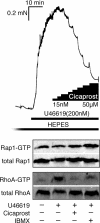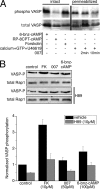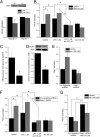The cAMP-responsive Rap1 guanine nucleotide exchange factor, Epac, induces smooth muscle relaxation by down-regulation of RhoA activity
- PMID: 21454546
- PMCID: PMC3089510
- DOI: 10.1074/jbc.M110.205062
The cAMP-responsive Rap1 guanine nucleotide exchange factor, Epac, induces smooth muscle relaxation by down-regulation of RhoA activity
Abstract
Agonist activation of the small GTPase, RhoA, and its effector Rho kinase leads to down-regulation of smooth muscle (SM) myosin light chain phosphatase activity, an increase in myosin light chain (RLC(20)) phosphorylation and force. Cyclic nucleotides can reverse this process. We report a new mechanism of cAMP-mediated relaxation through Epac, a GTP exchange factor for the small GTPase Rap1 resulting in an increase in Rap1 activity and suppression of RhoA activity. An Epac-selective cAMP analog, 8-pCPT-2'-O-Me-cAMP ("007"), significantly reduced agonist-induced contractile force, RLC(20), and myosin light chain phosphatase phosphorylation in both intact and permeabilized vascular, gut, and airway SMs independently of PKA and PKG. The vasodilator PGI(2) analog, cicaprost, increased Rap1 activity and decreased RhoA activity in intact SMs. Forskolin, phosphodiesterase inhibitor isobutylmethylxanthine, and isoproterenol also significantly increased Rap1-GTP in rat aortic SM cells. The PKA inhibitor H89 was without effect on the 007-induced increase in Rap1-GTP. Lysophosphatidic acid-induced RhoA activity was reduced by treatment with 007 in WT but not Rap1B null fibroblasts, consistent with Epac signaling through Rap1B to down-regulate RhoA activity. Isoproterenol-induced increase in Rap1 activity was inhibited by silencing Epac1 in rat aortic SM cells. Evidence is presented that cooperative cAMP activation of PKA and Epac contribute to relaxation of SM. Our findings demonstrate a cAMP-mediated signaling mechanism whereby activation of Epac results in a PKA-independent, Rap1-dependent Ca(2+) desensitization of force in SM through down-regulation of RhoA activity. Cyclic AMP inhibition of RhoA is mediated through activation of both Epac and PKA.
Figures









Similar articles
-
Activation of G protein-coupled estrogen receptor 1 induces coronary artery relaxation via Epac/Rap1-mediated inhibition of RhoA/Rho kinase pathway in parallel with PKA.PLoS One. 2017 Mar 9;12(3):e0173085. doi: 10.1371/journal.pone.0173085. eCollection 2017. PLoS One. 2017. PMID: 28278256 Free PMC article.
-
Activation of G protein-coupled bile acid receptor, TGR5, induces smooth muscle relaxation via both Epac- and PKA-mediated inhibition of RhoA/Rho kinase pathway.Am J Physiol Gastrointest Liver Physiol. 2013 Mar 1;304(5):G527-35. doi: 10.1152/ajpgi.00388.2012. Epub 2012 Dec 28. Am J Physiol Gastrointest Liver Physiol. 2013. PMID: 23275618 Free PMC article.
-
PKA and Epac cooperate to augment bradykinin-induced interleukin-8 release from human airway smooth muscle cells.Respir Res. 2009 Sep 29;10(1):88. doi: 10.1186/1465-9921-10-88. Respir Res. 2009. PMID: 19788733 Free PMC article.
-
Regulatory actions of 3',5'-cyclic adenosine monophosphate on osteoclast function: possible roles of Epac-mediated signaling.Ann N Y Acad Sci. 2018 Dec;1433(1):18-28. doi: 10.1111/nyas.13861. Epub 2018 May 30. Ann N Y Acad Sci. 2018. PMID: 29846007 Review.
-
Epac-selective cAMP analogs: new tools with which to evaluate the signal transduction properties of cAMP-regulated guanine nucleotide exchange factors.Cell Signal. 2008 Jan;20(1):10-20. doi: 10.1016/j.cellsig.2007.07.009. Epub 2007 Jul 25. Cell Signal. 2008. PMID: 17716863 Free PMC article. Review.
Cited by
-
Rap1 can bypass the FAK-Src-Paxillin cascade to induce cell spreading and focal adhesion formation.PLoS One. 2012;7(11):e50072. doi: 10.1371/journal.pone.0050072. Epub 2012 Nov 27. PLoS One. 2012. PMID: 23209645 Free PMC article.
-
Regulation of smooth muscle contraction by monomeric non-RhoA GTPases.Br J Pharmacol. 2020 Sep;177(17):3865-3877. doi: 10.1111/bph.15172. Epub 2020 Jul 19. Br J Pharmacol. 2020. PMID: 32579705 Free PMC article. Review.
-
Perspectives of PDE inhibitor on treating idiopathic pulmonary fibrosis.Front Pharmacol. 2023 Feb 14;14:1111393. doi: 10.3389/fphar.2023.1111393. eCollection 2023. Front Pharmacol. 2023. PMID: 36865908 Free PMC article. Review.
-
Rho-kinase: regulation, (dys)function, and inhibition.Biol Chem. 2013 Nov;394(11):1399-410. doi: 10.1515/hsz-2013-0181. Biol Chem. 2013. PMID: 23950574 Free PMC article. Review.
-
G Protein-Coupled Receptors in Asthma Therapy: Pharmacology and Drug Action.Pharmacol Rev. 2020 Jan;72(1):1-49. doi: 10.1124/pr.118.016899. Pharmacol Rev. 2020. PMID: 31767622 Free PMC article. Review.
References
-
- Somlyo A. P., Somlyo A. V. (2003) Physiol. Rev. 83, 1325–1358 - PubMed
-
- Somlyo A. P., Kitazawa T., Himpens B., Matthijs G., Horiuti K., Kobayashi S., Goldman Y. E., A. V. S. (1989) Adv. Prot. Phosphatases 5, 181–195
-
- Uehata M., Ishizaki T., Satoh H., Ono T., Kawahara T., Morishita T., Tamakawa H., Yamagami K., Inui J., Maekawa M., Narumiya S. (1997) Nature 389, 990–994 - PubMed
Publication types
MeSH terms
Substances
Grants and funding
LinkOut - more resources
Full Text Sources
Miscellaneous

